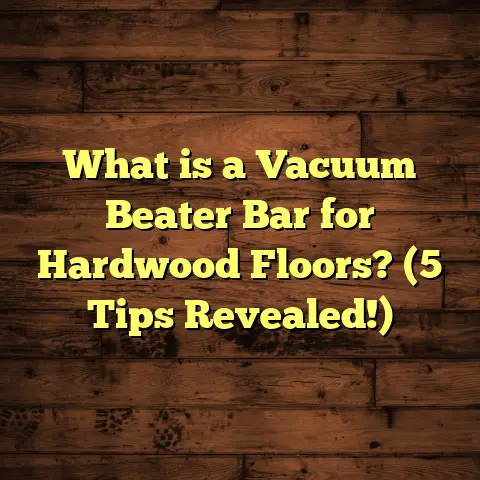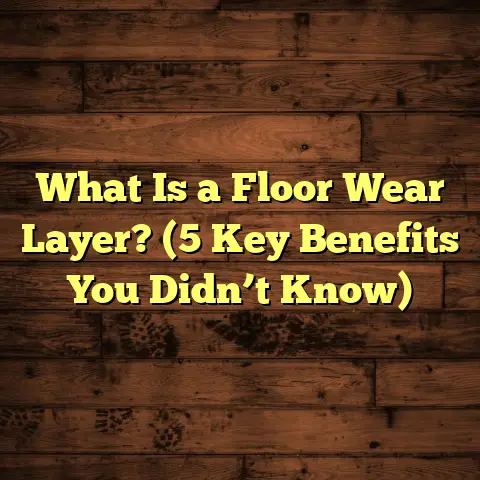What is More Comfortable: Tile or Vinyl Flooring? (5 Key Comparisons)
Waterproof Flooring Options: Why It Matters to Me
When I first started thinking about flooring options for my home, waterproofing was at the top of my list. Whether it’s spilled drinks in the kitchen, rainy shoes tracked into the mudroom, or the inevitable bathroom mishaps, having a floor that can handle moisture without warping or staining is essential. Both tile and vinyl flooring offer waterproof qualities, which makes them natural contenders in my search.
Waterproof flooring isn’t just about keeping things dry; it’s about peace of mind. I remember a friend’s basement flooding after a storm — hardwood floors got ruined, and the smell of mold lingered for months. That’s when I realized how much value waterproof floors have, especially in high-traffic or moisture-prone areas.
So which is better? Tile or vinyl? Let me share what I’ve learned over years of personal projects and professional experiences.
What is More Comfortable: Tile or Vinyl Flooring?
Comfort in flooring isn’t a one-dimensional thing. When I say “comfort,” I mean:
- How the floor feels underfoot (hardness, warmth)
- The noise level when walking on it
- How easy it is to stand or move around on for long periods
- How it handles temperature changes
- The effort needed for upkeep
Tile and vinyl are both waterproof but feel very different. Tile is hard and cool, while vinyl tends to be softer and warmer. I’ve spent hours standing on both during installations and daily life, so I’ll give you the lowdown from firsthand experience.
1. Comfort Underfoot: How Do They Feel?
Tile: The Solid, Cool Surface
Tile flooring is made from ceramic or porcelain clay that’s fired at high temperatures. This process creates an extremely hard surface that’s naturally waterproof. When I installed tile in my kitchen a few years ago, I immediately noticed how firm and cool it felt.
If you’re someone who likes walking barefoot on a solid surface, tile might be your thing. It feels sturdy and stable underfoot. But here’s the catch: that hardness can get tiring if you stand on it for hours — like when cooking or doing dishes.
Also, tile has poor heat retention. On cold days, unless you have radiant heating beneath, your feet might feel like they’re touching ice. That’s one reason I installed underfloor heating in my bathroom tile; it made a huge difference in comfort.
A study by the Flooring Industry Association found that people tend to rate tile floors as less comfortable for standing longer than 30 minutes compared to softer surfaces like vinyl or cork.
Vinyl: Cushioned Warmth
Vinyl flooring consists of multiple layers including a wear layer, printed design layer, and backing. This layered structure gives it some “give” when you walk on it.
When I first walked barefoot on vinyl in my laundry room, I noticed it felt warmer and less tiring than tile. This softness helps reduce foot fatigue — something anyone who spends time standing will appreciate.
Vinyl also retains heat better than tile, making it more comfortable in cooler seasons without needing additional heating systems. The National Floor Safety Institute reports that vinyl floors reduce foot discomfort by about 25% compared to tile in residential kitchens.
From personal experience and talking with clients, vinyl surfaces tend to be less slippery than glazed ceramic tiles, especially when wet—important if you have kids or elderly people at home.
2. Installation: How Easy Is It?
Installing Tile: A Labor of Love
Tile installation can be a rewarding project but requires patience and skill. The process involves:
- Preparing a perfectly flat subfloor
- Laying down mortar evenly
- Placing each tile carefully with spacers
- Cutting tiles to fit irregular spaces
- Applying grout between tiles
- Sealing grout to prevent stains and water infiltration
I remember my first time installing tile — it took me almost two full weekends because every step had to be precise to avoid uneven surfaces or cracked tiles later on.
If you’re not experienced, hiring a pro is usually necessary. Labor costs typically range from $4 to $10 per square foot, sometimes more for intricate patterns or smaller tiles.
One anecdote: A client once tried DIY tile installation but ended up with uneven tiles that trapped water in low spots. Fixing that required professional help later, showing that tile installation mistakes can become costly.
Installing Vinyl: Quick and Simple
Vinyl installation is much less complicated. Most modern vinyl flooring comes in peel-and-stick sheets or click-together planks that are easy to lay over existing floors with minimal prep.
I installed vinyl planks in my basement in a single afternoon — no grout, no mess, no mortar. If you want a quick update or rental property refresh, vinyl is incredibly convenient.
Vinyl installation costs tend to be lower because it’s less labor-intensive. Expect $1-$3 per square foot for labor if you hire someone.
Plus, if you ever want to switch styles or colors, removing vinyl is easier and less damaging to the subfloor than tile removal.
3. Maintenance and Longevity: What’s the Real Story?
Tile Maintenance: Durable but Needs Attention
Tile is famous for its durability. It resists scratches and dents better than most other flooring types. After installing tile in my kitchen and bathroom, I’ve seen it withstand everything from dropped pots to pet claws without damage.
But grout lines require maintenance to keep them clean and mold-free. Over time, grout can discolor or crack if not properly sealed.
I keep a special grout cleaner handy and steam clean annually to keep everything fresh. Using epoxy grout instead of cementitious grout during installation can reduce staining significantly.
In commercial settings like restaurants or hospitals, porcelain tiles last decades because they resist wear and moisture so well.
Vinyl Maintenance: Easy but Sensitive
Vinyl floors are easy to clean — sweeping and mopping with mild detergent usually does the trick.
However, vinyl can scratch more easily than tile. Sharp heels or pet nails can leave marks. I recommend using furniture pads under heavy chairs or tables to prevent dents.
Luxury Vinyl Tile (LVT) products often feature wear layers that protect against abrasion and fading. With proper care, LVT floors can last 15 to 20 years in residential use before needing replacement.
One client told me after switching from carpet to vinyl in their kitchen that cleanup after family meals became easier by 50%, thanks to vinyl’s stain resistance.
4. Appearance and Design Flexibility
Tile Design: Classic and Timeless
Tile comes in countless shapes, sizes, colors, textures, and finishes. Ceramic tiles can be glossy or matte; porcelain tiles can mimic marble or wood grain with incredible realism.
When I helped a homeowner pick tile for their bathroom remodel, we chose large-format porcelain slabs with a veined stone look. It made the space feel luxurious without breaking the bank.
Tile also allows for creative patterns like herringbone or mosaics if you want something truly unique.
The downside? Once set, tile design is permanent—changing it means breaking up the floor, which can be costly and disruptive.
Vinyl Variety: Endless Options for Every Style
Vinyl flooring has come a long way from the linoleum floors of decades past. With high-resolution printing technology, vinyl can replicate wood grain, stone textures, concrete finishes—even abstract art!
I recently saw a vinyl floor that perfectly mimicked reclaimed barn wood planks; honestly, I had to touch it twice before realizing it wasn’t real wood.
Vinyl also offers more flexibility for renters or those who like changing décor frequently because it’s easier to install and remove without damage.
5. Cost Considerations: Budgeting Without Surprises
Tile Costs: Material + Labor = Higher Price Tag
The material cost for ceramic tiles ranges from $1 to $5 per square foot; porcelain costs more—up to $10 or more for premium styles like natural stone look-alikes.
Installation is labor-intensive and can double or triple material costs depending on complexity:
| Material Type | Material Cost per sq.ft | Installation Cost per sq.ft | Total Estimated Cost per sq.ft |
|---|---|---|---|
| Ceramic Tile | $1 – $5 | $4 – $7 | $5 – $12 |
| Porcelain Tile | $3 – $10 | $5 – $10 | $8 – $20 |
If you’re planning a large space like a kitchen plus bathroom floors, these costs add up fast.
Vinyl Costs: More Affordable Upfront
Vinyl plank flooring generally costs between $2 and $7 per square foot for materials alone. Installation is straightforward so labor may only add $1-$3 per square foot:
| Vinyl Type | Material Cost per sq.ft | Installation Cost per sq.ft | Total Estimated Cost per sq.ft |
|---|---|---|---|
| Standard Vinyl | $1 – $3 | $1 – $2 | $2 – $5 |
| Luxury Vinyl Tile | $3 – $7 | $1 – $3 | $4 – $10 |
I’ve found that budget planning tools like FloorTally help me get accurate estimates based on local labor rates and material prices. It even factors in waste percentages so I’m not caught off guard ordering too little or too much material.
That way I can confidently plan projects — no surprises.
Personal Stories & Case Studies From My Flooring Projects
Case Study 1: Kitchen Remodel with Porcelain Tile
A family I worked with wanted a sleek kitchen floor that would last decades despite heavy cooking days. We chose large-format porcelain tiles with subtle texture for slip resistance.
During installation, we added radiant heat mats under the tiles for warmth during winter mornings—completely changed how comfortable they felt standing there at breakfast prep time.
Two years later they reported zero issues with stains or wear despite daily spills and heavy foot traffic from kids and pets.
Case Study 2: Basement Renovation Using Luxury Vinyl Planks
In another project, a homeowner needed waterproof flooring for a basement rec room prone to humidity but wanted warmth underfoot for kids playing on the floor.
We went with luxury vinyl plank flooring featuring an attached cork underlayer for extra cushioning and sound absorption.
Post-installation feedback was positive — they loved how soft the floor felt compared to their old concrete slab plus ease of cleaning after games and snacks on the floor.
My Own Experience: Balancing Comfort & Durability
When choosing floors at home, I weigh how often I stand on them versus how much wear they’ll get. For instance:
- Kitchen? I prefer vinyl because I’m on my feet cooking a lot.
- Bathroom? Tile with radiant heat because water exposure is high.
- Living room? Hardwood or soft vinyl depending on style preference.
It’s about finding the right balance between comfort and practicality for each room’s use case.
Additional Factors That Affect Comfort Between Tile & Vinyl
Temperature Regulation & Heating Options
Tile’s thermal conductivity means it can feel cold but also heats up quickly with radiant systems. Vinyl tends to insulate better naturally but doesn’t conduct heat as well if you want underfloor heating.
I’ve experimented with both setups; radiant heat under tile is ideal if you want warm floors but requires investment upfront.
Noise Impact
Tile floors tend to amplify footsteps and echoes due to their hardness—something I noticed when friends visited my tiled kitchen vs my vinyl-floored living room which muffled sounds nicely.
If noise is an issue, adding rugs over tile helps but vinyl naturally absorbs more sound.
Environmental Impact & Sustainability
Vinyl is synthetic and derived from petroleum products; some people prefer natural materials like ceramic tile for eco reasons despite higher energy consumption during manufacture.
Newer lines of recycled-content vinyl aim to reduce environmental footprint while maintaining waterproof qualities—good to know if sustainability matters to you.
My Tips For Choosing Between Tile & Vinyl for Comfort
- Think about where you spend most time standing—vinyl’s softer feel might save your feet.
- Consider climate—tile with radiant heat wins if you want warm floors without bulky rugs.
- Factor in household members—kids and pets might benefit from slip-resistant vinyl.
- Budget realistically—tile lasts longer but costs more upfront.
- Use online tools like FloorTally early on to estimate true project costs based on your location.
These strategies helped me avoid buyer’s remorse many times!
Summary of Key Comparisons
| Feature | Tile | Vinyl |
|---|---|---|
| Feel Underfoot | Hard & cool | Soft & warm |
| Installation | Complex & labor-intensive | Easy & DIY-friendly |
| Maintenance | Grout needs care; durable | Scratch-prone; easy clean |
| Design Options | Extensive & permanent | Highly versatile & replaceable |
| Cost | Higher upfront | More affordable upfront |
| Noise | Amplifies footsteps | Absorbs sound |
| Longevity | 30+ years typical | 15-20 years typical |
Choosing between tile and vinyl really comes down to what kind of comfort you value most: firmness and longevity or softness and warmth. Both are excellent waterproof choices that stand up well in wet areas when properly installed and maintained.
If you want me to help you figure out which option suits your lifestyle best or need tips on installation techniques or care routines, just ask! Flooring isn’t just about looks—it’s about creating spaces where you feel good every step of the way.
Would you like me to help compare specific brands or styles? Or maybe walk through installation steps for either flooring type? Just say the word!





